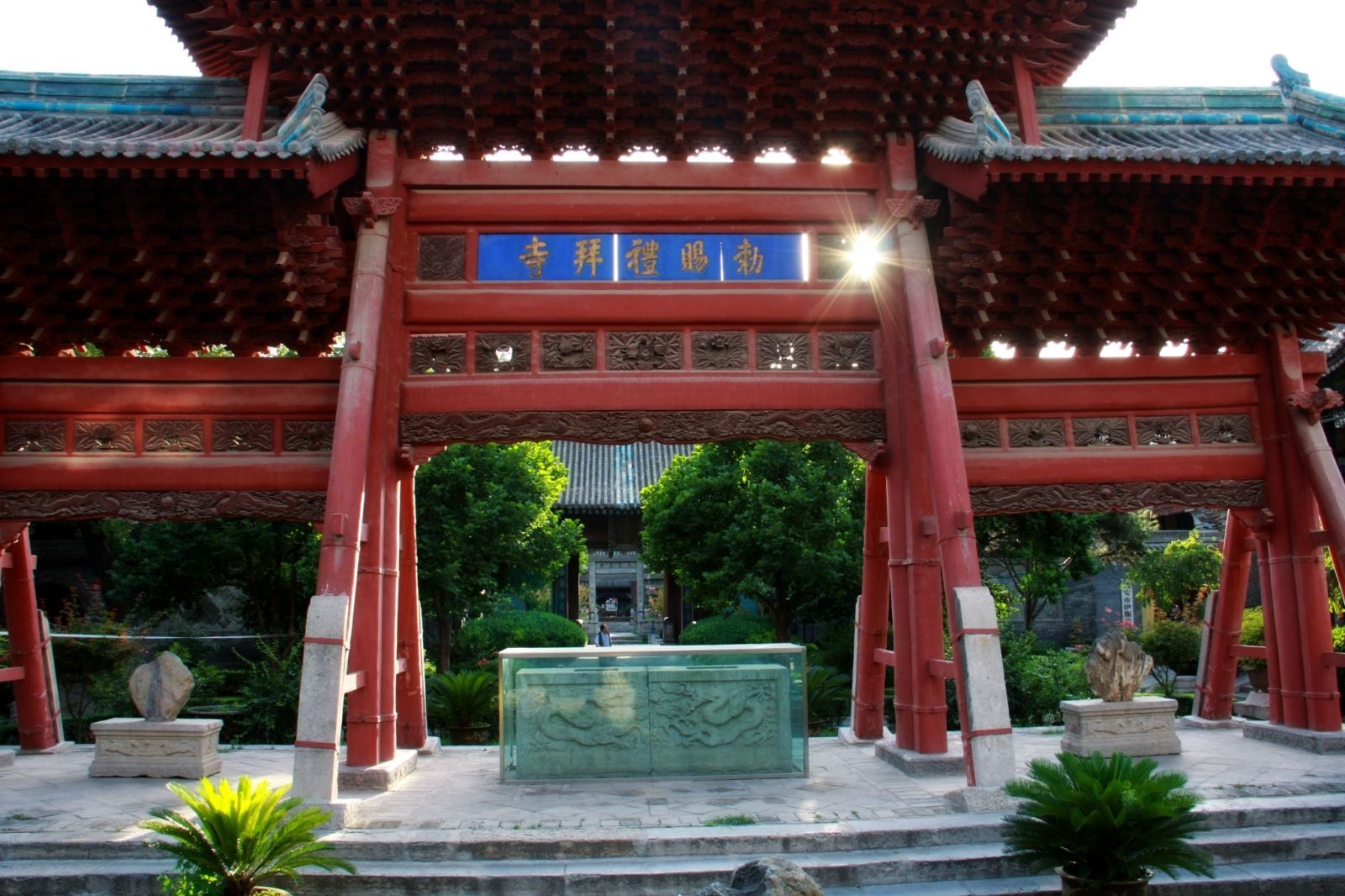Chinese Name: 清真大寺 Pronunciation: qīng zhēn dà sì
Building Time: 742 AD
Best Visiting Season: All seasons
Suggested Visiting Hours: 1-2 Hours
Occupied Area: About 13,000 square meters
Building Area: About 6,000 square meters
Building Function: Built for Muslims worship in ancient times
Address: No.30 Huajue Lane, Lianhu District, Xi'an City, Shaanxi Province
Opening Hours: 8:00-19:00, from Monday to Sunday,from January to December (In summer, sometimes, the Great Mosque won’t close until 20:00.)
| Tickets |
Peak Season
(March-November)
|
Low Season
(December- February of next year)
|
| Admission Fee | 25 yuan | 15 yuan |

The Great Mosque, located in Huajue Lane, Xi'an, is the key cultural relics units under the protection of Shaanxi Province. The entire mosque is an east-west rectangle, surrounded by blue brick walls. It is divided into four courtyards, with a total construction area of more than 6,000 square meters.
The Great Mosque is different from those in Arabian. The mosques in Arabian possess splendid domes, dazzling patterns and skyward eaves. However, the Great Mosque is based on the Chinese architectural style and cultures of other countries. All the layouts in the Great Mosque are arabesque decorations of the Islamic system. The decorations are composed of Arabic carvings, the architecture of traditional Chinese, and the architecture with Islamic style. Such a wonderful combination is impressive, and it is listed as one of the world's Islamic cultural relics by UNESCO.
There is no doubt that mosques always represent Islam and how it was introduced to China. Islam first emerged on the Arabian Peninsula in the seventh century AD. And it was introduced to China from West Asia and the Middle East in the middle of the seventh century. After a long period of development and evolution, Islam with Chinese characteristics has been formed. It is the link between long-term economy, cultural communication, and friendship between Chinese and Arab people.

In 742 AD, the Great Mosque was built. Then it underwent maintenance and protection in the Song, Yuan, Ming, and Qing Dynasties, thus forming the one we can see today.
In 1956, the Great Mosque was announced as the provincial key cultural relics protection units by the government of Shaanxi Province.
In 1988, the Great Mosque was selected as one of the third batches of national key cultural relics protection units.
In May 1997, it was awarded one of the top ten tourist attractions in Xi'an.
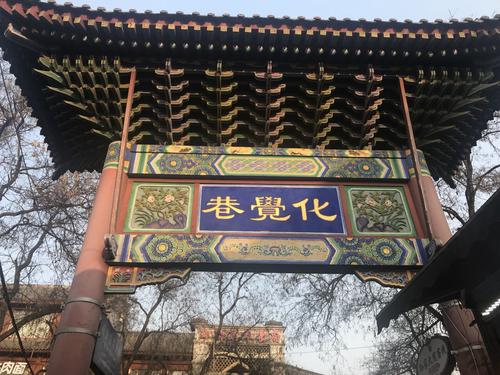
There are four courtyards in the Great Mosque. In the first one, there is a wooden archway that you should not miss. The wooden archway was built in the early 17th century, with a history of 360 years. It is 9 meters high with roofs of glazed tile, and cornices of different angles. There are respectively three rooms in the southern and northern parts of the first courtyard. In these rooms, the Ming and Qing Dynasties’ furniture is exhibited.

After entering the second courtyard, it is can be seen that a stone archway with three doors and four pillars stands in the center of the second courtyard. On the central lintel stone plaque, four characters “天监在兹” are carved. The meaning of these four characters is ‘now, God is monitoring our behavior’.
In the second courtyard, there are calligraphy works from the great calligrapher Mi Zhu of the Song Dynasty and Dong Qichang of the Ming Dynasty. Their handwriting is elegant and smooth which can be called masterpieces of Chinese calligraphy.
When entering the third courtyard, people must pass through the Chici Hall. It is the oldest hall in this Mosque. In the hall, there are seven stone steles, with inscriptions in Arabic, Persian, and Chinese.

Behind the Chici Hall, in the center of the backyard, there is a three-storey octagonal building called the Retrospection Tower. Its function is the same as the minaret in the mosque in Arabian. Orders are often sent from the tower top to call the Muslims to worship. On the railings downstairs, there are stone carvings of “Two Dragons Playing a Pearl”, which are said to be the relics of the Tang Dynasty.
In the traditional Arab mosques, four minarets should be built, but there is only one "Retrospection Tower" in the Great Mosque on Huajue Lane. And the Retrospection Tower is built on the central axis of the Mosque, reflecting Chinese architectural characteristics. It is said that the plaque hanging on the tower was inscribed by Yan Song of the Ming Dynasty.
There are scripture halls in the south and north of the courtyard. In the scripture halls, there are “Quran” in Arabic and the Chinese translation, precious calligraphy, paintings, porcelain vases, and other furnishings.

Entering the fourth courtyard, the Yizhen Pavilion is located in the center of the courtyard. The Yizhen Pavilion is also known as Phoenix Pavilion because it is like a phoenix spreading its wings.
There are seven halls in the north and south of the fourth courtyard, which were originally built by civil and military officials. They received the emperor's "sacred decree" from the feudal court. There is a stone stele gallery behind the south hall, with the inscriptions showing the creation and reconstruction of the mosque. Behind the Yizhen Pavilion, there is a begonia-shaped fountain.
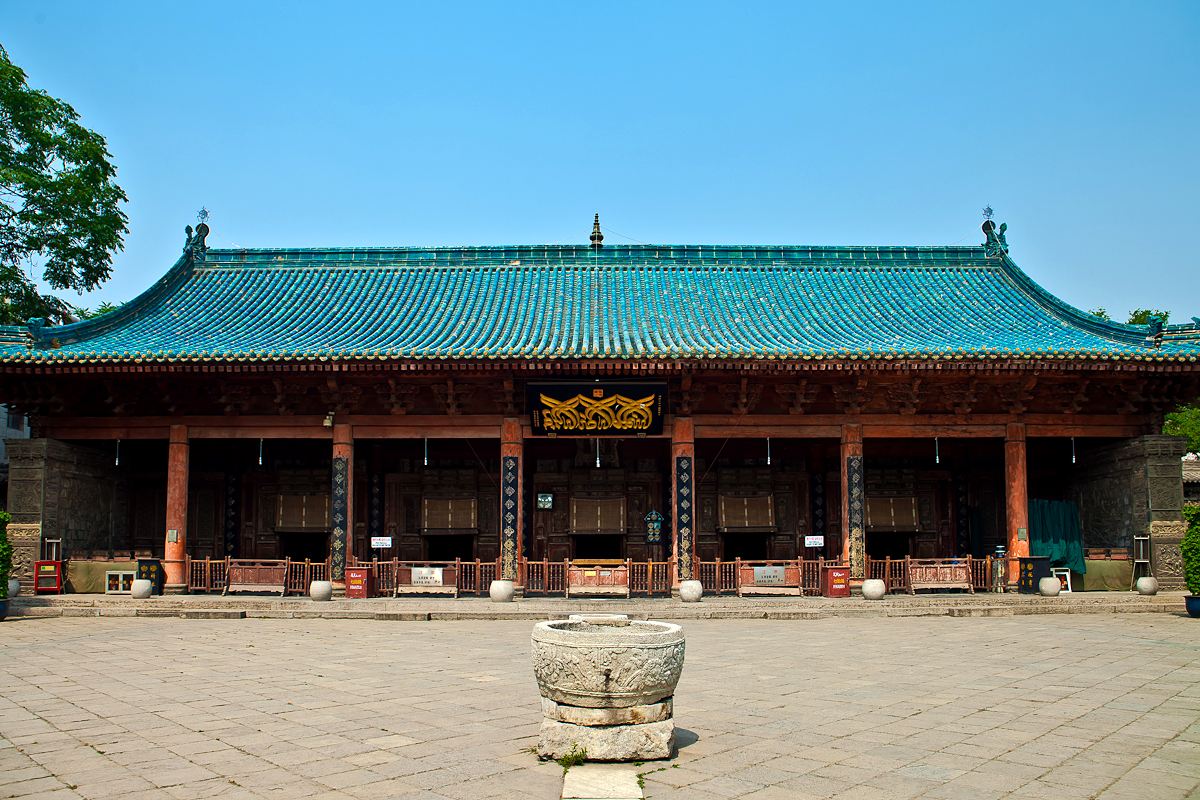
The Prayer Hall covers an area of about 1,300 square meters. And it can accommodate more than 1,000 people for worship at the same time. There are six hundred paintings on the ceilings in the hall. The colorful paintings have different styles. The center of each painting is Arabic "Duwa". The surrounding walls are carved with arabesque and the Quran.
A magnificent, quiet, and solemn Islamic building--Dongguan Mosque stands at the south of Dongguan Street, Xining City. It is the center of religious activities of hundreds of thousands of Muslims in Xining City. It is not only one of the four major mosques in China but also the largest and oldest mosque in China. And in terms of the number of Muslims under its jurisdiction, it ranks fifth in the Islamic world.
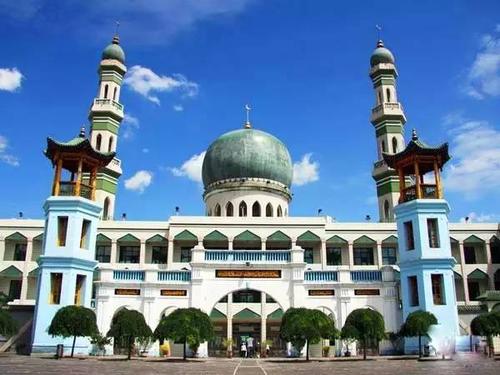
Dongguan Mosque was built during the Hongwu period of the Ming Dynasty around 1380 AD. Through the two inscriptions in the existing mosque, “Reconstruction of Xining Great Mosque Stele” (established in May 1914) and “Reconstruction of Xining Dongguan Great Mosque Stele” (established in August 1948), We can see the vicissitudes experienced by this Great Mosque with a history of more than 500 years.
The architecture of the Dongguan Mosque fully reflects the superb architectural art and unique architectural style of the local Hui nationality people. The south gate facing the street is an eye-catching western-style three-door, with the bigger door in the middle and two small ones on the left and right, harmonious and majestic. The top of the gate is embedded with six Chinese golden words, shining brightly.
Since its establishment, the Dongguan Mosque has not only become the main place for the majority of Muslims in Xining to conduct religious activities, but also been one well-known scenic spot inside and outside the province for its complete Islamic sutra education system and high-level Islamic studies. Since the Republic of China, the founders and heirs of Islam have used Dongguan Mosque as the central Mosque. They have gathered many people and trained imams in turn, and have studied and preached various Islamic classics and related things. The doctrine of this sect has cultivated and brought up a large number of Islamic scholars from other provinces and cities, and it contributed to the rapid development of the sect in the future.
Nanguan Mosque is a building with Arabic style and ethnic characteristics. Many precious pines and various trees and flowers are planted in it. The entire building has a strict layout, compact structure and grand scale. It was rebuilt in 1981 and is located in the southeast corner of Yinchuan City. It is a central place for the Hui nationality people in Yinchuan to conduct religious activities. Hundreds of Muslims gather here for pilgrimages and worship on Juma Day or every traditional Hui national holiday.
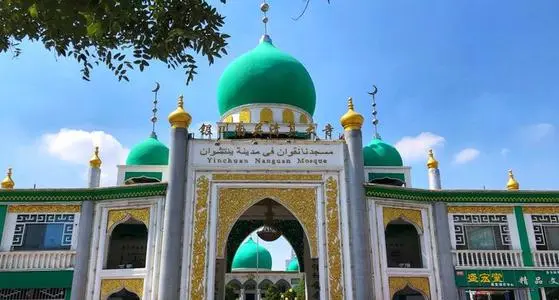
The Nanguan Mosque was built a long time ago. At the end of the Ming Dynasty(1368-1644), the original Mosque was located in the site of “Gongbei” pavilion outside the Nanguan gate of Yinchuan. In 1916, the Mosque was moved inside Nanguan gate, and a large Mosque with a classical style was built. The Mosque was destroyed in the 1960s. In 1981, the majority of Muslims raised funds to rebuild the site.
The Nanguan Mosque has become one of the most important religious venues and tourist attractions in the autonomous region due to its unique, elegant and solemn characteristics, as well as strong Islamic architectural style. In recent years, leaders, messengers and friends from more than 90 countries and regions have visited it. Many overseas Muslims also visit and worship here.
The main hall of the reconstructed Nanguan Mosque is 26 meters high and sits west facing east. The Mosque owns an area of about 10,000 square meters. The main hall has two floors with a circular vault, and the upper floor is the main hall and balcony. The square worship hall can accommodate more than 1,300 people for worship. On the lower floor, there are spacious bathing rooms, small worship halls, women’s worship halls, Arabic schools, imam bedrooms, offices, reception rooms, etc., all connected by a corridor.
Id Kah Mosque (Uyghur: Héytgah Meschit) is located on Jiefang South Road in the center of Kashgar, Xinjiang, China. It is the largest mosque in Xinjiang and one of the three most influential mosques in Central Asia. Id Kah Mosque was built in 1442. It is the largest Islamic worship temple in Xinjiang and even in the country. It has a certain influence in the religious circle at home and abroad and is a key cultural relic protection unit in the autonomous region, covering an area of 16,800 square meters. It is located on the west side of Id Kah Square in the center of Kashgar.
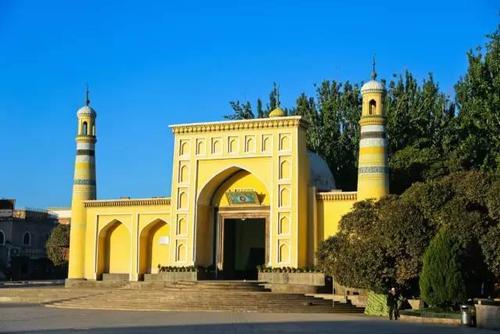
This is an ancient Islamic architectural complex with a strong ethnic and religious style. It sits west and faces east. It consists of four parts: Mosque towers, gardens, scripture halls and worship halls. This was originally the cemetery of Islamic missionaries left by the Arab general Qudibo Ibn Muslim who conquered Central Asia. In 1442, King Shaksezi Mirza of Kashgar first established a mosque here. In 1538, the ruler of Kashgar, Ubuli Abdik, extended the monastery to commemorate his late uncle. In the 16th century, the monarch of the Yarkand Khanate expanded it into a great-scale Mosque, where the Jumu’ah activity can be held.
In 1798, Guregena, one Uyghur female Muslim from Yingjisha, died in Kashgar on her way to Pakistan. People used her leftover travel expenses to expand the mosque and named it “Id Kah”. Later, a wealthy Uyghur woman, Zhuoli Piya Khan, donated funds for the expansion and purchased 400,000 square meters of land as a mosque property. At present, this place has become a gathering place for all Muslims in Xinjiang Uygur Autonomous Region. The number of people who worship here reaches about 3,000 every day, and the number of male Muslims worshipping on Friday afternoon reaches about 7,000. During the Gurban festival, Muslims from all over Xinjiang come to rejoice with wild excitement all night.
Enter from the front gate of the Mosque→Wooden Memorial Archway→Stone Memorial Archway→Chici Hall→Retrospection Tower→Yizhen Pavilion→the Prayer Hall
Take bus 15, 205, 32, 618, 612, 252, 251, 222, 221, 215, and get off at the Zhonglou Xi (Bell Tower West) Station. Then walk north to the Drum Tower and then walk northwest along the Huajue Lane for about 5 minutes to arrive at the Great Mosque.
By Subway
Take Metro Line 2 and get off at Zhonglou (Bell Tower) Station, and then get out from Exit B and walk towards the west for about 6 minutes, you can see the Drum Tower.
And then walk northwest along the Huajue Lane for about 5 minutes to reach the Great Mosque.
By Taxi
Chinese: 请带我去清真大寺。English: Please take me to the Great Mosque.
Chinese: 请带我去清真大寺的正门。English: Please take me to the Front Gate of the Great Mosque.
Chinese: 请带我去化觉巷。English: Please take me to Huajue Lane.
If you go to the Great Mosque from Xianyang International Airport, it takes about 70 minutes. (About 100 yuan)
If you go to the Great Mosque from Xi’an Railway Station, it takes about 30 minutes. (About 20 yuan)
If you go to the Great Mosque from Xi’an North Railway Station, it takes about 1 hour. (About 50 yuan)
